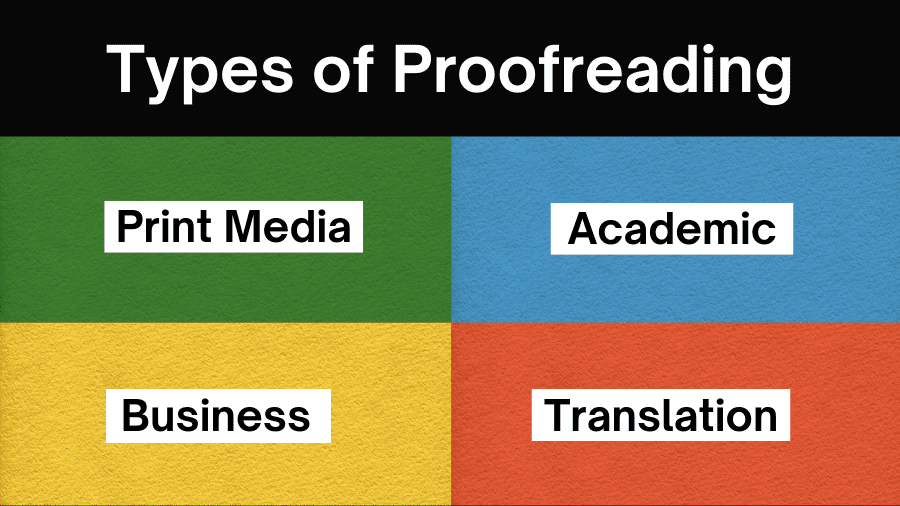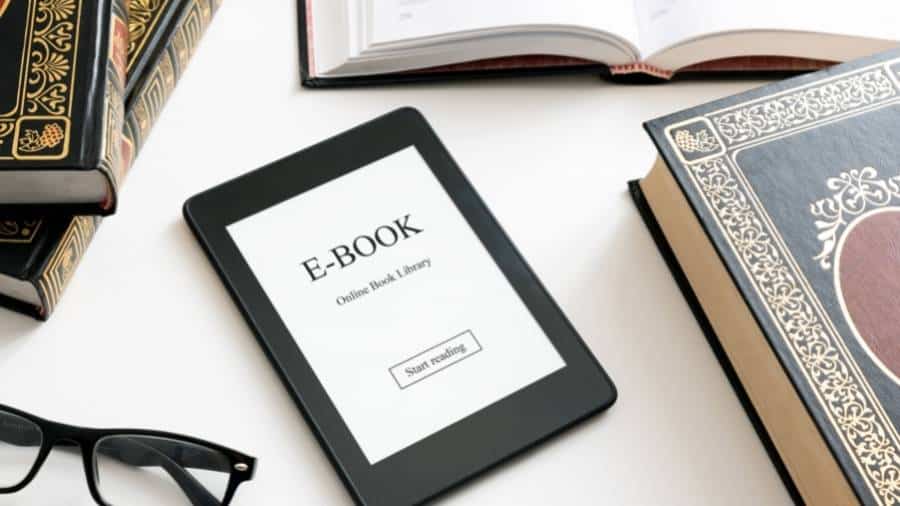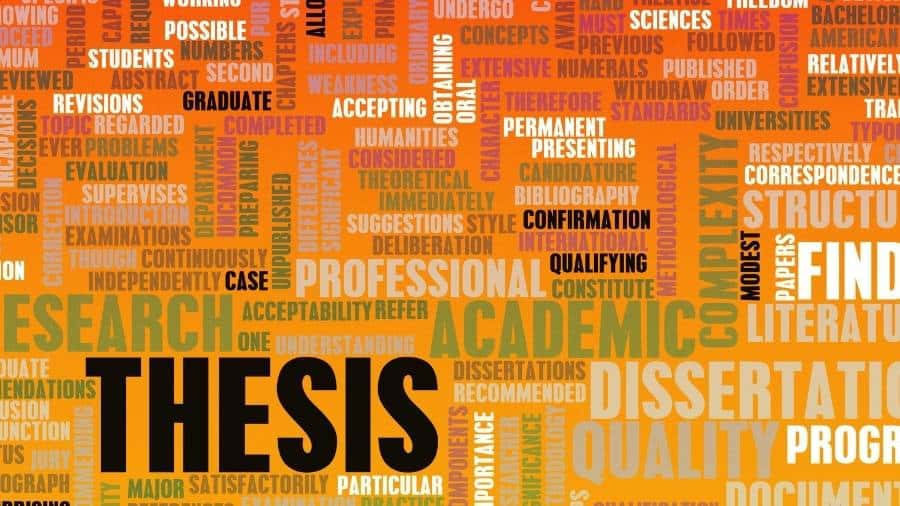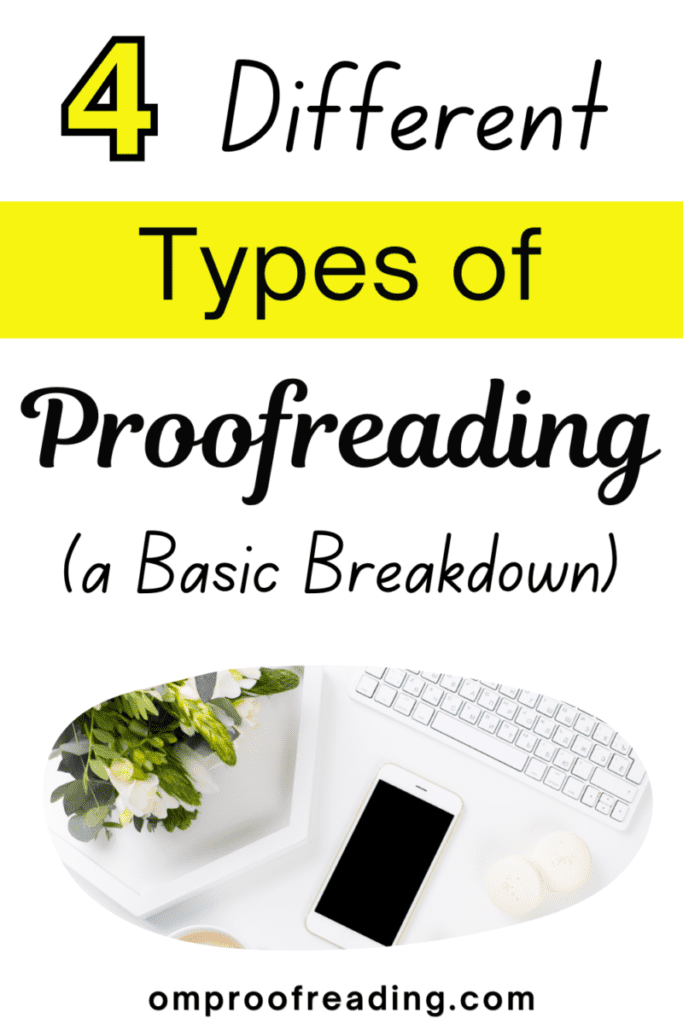This article may contain affiliate links. Please see our affiliate disclaimer in the footer menu for more information. Thank you for your support!

If you’re contemplating becoming a proofreader or need a document proofread, you may wonder how many types of proofreading exist. As a trained proofreader, I’ll explain four different types of proofreading and give you examples of texts that fall under each kind.
At the end of this article, I’ll provide the names of a few well-respected companies that offer proofreading services for all the kinds of proofreading we discuss.
How Many Types of Proofreading Are There?
So how many kinds of proofreading exist? Well, it depends on who you ask. Some questions have definite answers. For example, if you asked me how many primary colors there are, I would say three.
And if you asked me how many stages make up the editorial process, I would say four: developmental editing, line editing, copyediting, and proofreading.
But when it comes to types of proofreading, we don’t have a clear-cut answer.
For this article, I chose to include four main types of proofreading. These are the four kinds people are most familiar with.
THE FOUR TYPES OF PROOFREADING
- print media proofreading
- academic proofreading
- business proofreading
- translation proofreading
We’ll learn more about each of these types soon. But first, let’s briefly discuss what proofreading involves.
WHAT ARE THE BASICS OF PROOFREADING?
Proofreading is the final step in the editing process. It involves the following tasks:
- correcting errors with punctuation, grammar, capitalization, spelling, and formatting
- fixing improper word choices
- looking for omitted or repeated words
- ensuring a text follows the appropriate style guide
If you’d like a complete picture of this editing stage, I penned a post about proofreading.
And I authored an article about proofreading tips if you need helpful strategies for polishing your writing.
Now let’s look at the four different types of proofreading.
The Different Types of Proofreading
1) Print Media Proofreading

You’re probably most familiar with print media proofreading. Proofreaders of print media work for publishers or self-publishing authors.
Proofreaders working for publishers typically proofread a typeset document. These documents already have the text carefully laid out on the pages and are ready for printing.
Proofreaders of typeset documents either work with a hard copy or a PDF. Occasionally, they use proofreading symbols when working with a hard copy.
When proofing a PDF, they use PDF markup tools in a software called Adobe PDF editor.
Proofreaders who work for self-publishing authors generally proof texts in MS Word or Google Docs.
In Word, they use the Track Changes tool to let clients see all the recommended changes. When working with Google Docs, they use a similar tool called the Suggesting feature.
I wrote an article about what software proofreaders use if you’re interested in learning more about this aspect of proofreading.
No matter what software a proofreader uses to do print media proofreading, or any type of proofreading, their aim is always the same: to make the writing as error-free and polished as possible before it’s published for the masses to read and enjoy.
Examples of Print Media Documents
- books and e-books (fiction and nonfiction)
- newspapers
- magazines
- screenplays
- greeting cards
- directories
Commonly Used Style Guides for Print Media Proofreading
Although some publishers have their own style guides, these are the two most widely used guides in the publishing industry:
- The Chicago Manual of Style (for fiction and nonfiction books)
- The Associated Press Stylebook (for newspapers and magazines)
Unique Considerations for Print Media Proofreading
As with all types of proofreading, print media proofreading involves a few special considerations.
Proofreaders working with typeset documents must pay close attention to one element: formatting.
For example, proofreaders flag widows. A widow is a short final line of a paragraph that appears at the top of the next page. It’s not visually pleasing, so proofreaders point these out.
Widows don’t happen in website copy because multiple pages aren’t involved—you just keep scrollin’ on down one continuous page. 😊
Here are a few other examples of what proofreaders check for in print media proofreading:
- proper word breaks
- appropriate margins
- correct page number sequences
Aside from making sure all design specs are met, proofreaders of print media may need to consider a few additional features.
For example, book proofreaders may need to check for mistakes in ancillary content like the following:
- tables of contents
- indexes
- appendixes
They must also ensure proper and consistent formatting for these elements and check cross-references.
A cross-reference is when one place in a document directs you to pertinent information in another part of the same document.
2) Academic Proofreading

Academic proofreading involves proofreading the work of professors and researchers in academia and students at all university levels. Professors and researchers need a proofreader to tidy up the articles they want to submit to journals.
Elsevier, a well-known publishing company, claims that 30%–50% of the articles they receive are rejected prior to the peer-review process (source). One of the reasons they give for disapproving a paper is that it’s incomprehensible.
“The language, structure, or figures are so poor that the merit can’t be assessed. Have a native English speaker read the paper. Even if you ARE a native English speaker.”
– Elsevier
Many non-native speakers use academic proofreading services to increase the likelihood of their articles being published in English-based journals. Of course, native speakers need their papers to be as polished as possible too.
Students who want to get better grades or be accepted to their college of choice also turn to academic proofreading.
College admissions boards are sticklers for good grammar and punctuation, and most college professors are too.
However, students need to be aware of scenarios where having their work proofread may be prohibited (e.g., an ESL or English literature course).
Examples of Academic Documents
- essays
- research papers
- theses
- dissertations
- journal articles
- college admissions essays
- personal statements
- statements of purpose
Commonly Used Style Guides for Academic Proofreading
Although some colleges and universities have their own style guide, here are the most widely used style guides for academic proofreading:
- the MLA (Modern Language Association) Handbook (for the humanities, particularly literature)
- the Publication Manual of the American Psychological Association (for behavioral and social sciences)
- The Chicago Manual of Style (for the humanities, particularly history)
Unique Considerations for Academic Proofreading
Those who do academic proofreading have specific areas of concern.
Like print media proofreading, academic proofreading requires a lot of know-how with formatting.
Here are a few examples of items that need to be correctly formatted according to the style guide being used:
- citations, footnotes, and endnotes
- regular and block quotations
- works cited, reference lists, and bibliographies
Proofreaders will also verify that all sources cited in the paper appear on the works cited or reference list. And they’ll do the opposite. That is, if the author lists the name of a source that ends up not being used in the paper, they’ll nix it from the page listing the cited sources.
However, they’ll be aware that a bibliography often contains all the sources the author referenced for the paper, even if they aren’t cited in the document.
If the proofreader is well-versed in the paper’s subject, they’ll be better able to catch technical terms that aren’t used properly.
I wrote a thorough article about academic proofreading if you’d like to learn more.
3) Business Proofreading

Business proofreading involves proofreading content written by business owners. I’m also going to include job seekers in this category.
Our first impression of an organization is often via written content.
If a company can’t be bothered to publish polished content that contains sound grammar and punctuation, we may assume they can’t be bothered to offer a high-quality product or service either.
Job seekers opt to use proofreading services to improve their chances of being hired.
Forbes published an article about why résumés get rejected. They cited poor editing as one of the reasons.
“There’s no room for spelling or grammar goofs in your resume.”
– Forbes
Having a second pair of eyes to clean up any blunders in business writing can be invaluable, leading to more customers for companies and more opportunities for job seekers.
Examples of Business Documents
- reports
- PowerPoint presentations
- emails
- newsletters
- blog posts and other website copy
- product descriptions
- user manuals
- white papers
- press releases
- grant proposals
- CVs
- résumés
- cover letters
Commonly Used Style Guides for Business Proofreading
Some companies have their own style guide. However, here are the two most widely used style guides for business proofreading:
- The Chicago Manual of Style
- The Associated Press Stylebook (often used by marketing agencies)
Unique Considerations for Business Proofreading
Business proofreading requires a bit more knowledge in a few areas.
Business proofreaders need to be aware that every company has its own voice—often referred to as a brand voice.
Brand voice refers to a company’s tone when addressing its target audience. Some companies may use casual language infused with humor—an informal tone.
Other companies, however, will opt for a serious tone because formal language is more appropriate for the scope of their business.
Also, proofreaders need to make sure that the names of people, products, and brands are spelled correctly. These terms don’t appear in dictionaries, and misspellings won’t be detected by spell-check.
A misspelled name looks particularly unprofessional. Yikes!
Furthermore, proofreaders of business writing will look for undefined acronyms and initialisms that may be unknown to a company’s target audience. And if proofreading online content, they’ll verify that links lead to the right place.
Finally, since business writing is concise, proofreaders need to ensure that bulleted and numeric lists are formatted correctly and consistently.
Speaking of numbers, proofreaders try to guard against misplaced decimal points since those can significantly impact numeric data.
4) Translation Proofreading (Monolingual and Bilingual)

As the name suggests, translation proofreading deals with proofreading a document that has been translated from one language to another.
We can divide translation proofreading into two types: monolingual and bilingual.
Monolingual proofreading is done by a proofreader who knows the language of the final document (target language) but not the language of the original document (source language).
Monolingual proofreading only deals with the document that’s been translated, not the original text.
Bilingual proofreading is done by someone who knows both the target and source language. A bilingual proofreader works with the original text and compares it to the translated version.
Examples of Translation Documents
- Any kind of document may need translation (so many possibilities here!)
Commonly Used Style Guides for Translation Proofreading
- It depends on the kind of document being proofread
If you’d like to learn more about style guides, I published a post called “What Is a Style Guide in Proofreading? (+ How to Use One).”
Unique Considerations for Translation Proofreading
Monolingual proofreading is similar to regular proofreading, so the specific considerations will depend on the type of text being proofread.
However, bilingual proofreaders have additional considerations.
Of course, their primary concern is that the translated version accurately conveys the meaning of the original document.
They’ll verify that none of the original document’s content has been omitted and that none of the language in the translated text is culturally inappropriate for the target audience.
Reputable Companies that Offer Proofreading Services
If you need proofreading for a document, each company listed below offers a proofreading service that encompasses all the types of proofreading mentioned in this article.
These are all well-respected businesses that provide instant price quotes and a turnaround time (TAT) of six hours or less, in case you’re in a rush.
| Company | Trustpilot Rating (# of reviews) | Fastest TAT Available |
|---|---|---|
| Proofed | 4.7 (386) | 3 hours (3,000 words or fewer) |
| Scribendi | 4.5 (392) | 4 hours (1,500 words or fewer) |
| ProofreadingServices.com | N/A* | 6 hours |
*ProofreadingServices.com is a well-respected company that isn’t rated on Trustpilot. However, given its rigorous hiring standards and clients like Harvard University, MIT, and Cisco, I feel comfortable including it on this list.
Many other businesses provide a combined proofreading and editing service, which is typically more expensive than just proofreading.
If you need proofreading only, the companies above have you covered.
But if you want more information about these businesses or need more than proofreading (i.e., copyediting or editing), please see my article about services that offer fast turnaround times.
Furthermore, if you have an academic text, these services are ideal for proofreading academic writing.
And if you possess a print media document, these companies are the best for book editing and proofreading.
I hope this article has enabled you to become familiar with the principal types of proofreading.
If you read this post to determine what kind of proofreading work you’d like to do, you may want to check out my article about proofreading jobs for newbies.
Best wishes to you!
“Keep your face always toward the sunshine, and shadows will fall behind you.”
– Walt Whitman

Recent Posts
Punctuation is important because it enables us to communicate our message clearly and effectively. Without punctuation, we wouldn’t understand how units of a sentence relate to one another or how...
Although you're probably somewhat familiar with adverbs, you may be unaware of sentence adverbs. As a trained proofreader who has studied the parts of speech, I can help you understand this unique...
